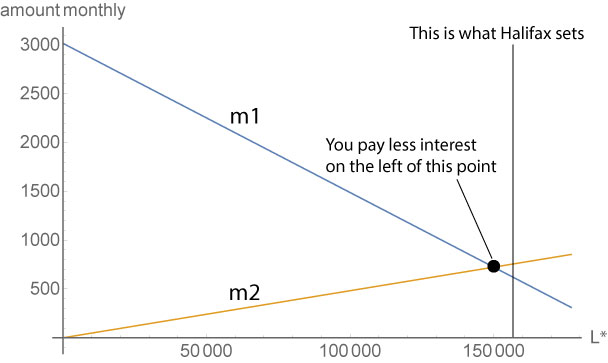25 May 2017: A tax on those who can't do maths
It's said that playing the lottery is akin to imposing a tax on those who cannot do mathematics. However, there are plenty of real-life situations where it becomes difficult to gauge whether or not you are getting a good deal. Issues of real-estate, investment, and mortgaging is one of those situations.
Here's a typical situation that will be familiar to a lot of our readers. You would like to take out a mortgage of a certain amount, let's say $L = L_0$. Currently, Halifax has a deal where they will charge you a fixed rate of $r_1 = 2.11\%$ interest on the first $t = n_1$ months. For the remainder of the time, up to $t = n_e$, they will charge the variable rate, which for simplicity we assume to be at $r_2 = 3.74\%$.
Now when you fill out the details of the mortgage on their calculators, it will indicate how much you should be paying back per month, and this takes the form of a fixed amount $m_1$ for the first period and $m_2$ for the second. The question is then: how are $m_1$ and $m_2$ determined? Clearly, if $m_1$ is very large, then this is typically in your best interest, as you profit from the better interest rate. Is the rate they set in your favour or theirs?
This turns out to be a question of recurrence relations. Let $L_n$ be the current loan amount in the nth month. During the first period, $0 < n < n_1$ we can verify that \[ L_n = L_{n-1}(1 + r_1/12) - m_1, \]
where $r_1 = 0.0211$ is the interest rate and it is assumed to be compounded monthly. From this, it follows that \[ L_n = k_1^n L_0 - m_1 \left(\frac{1 - k_1^n}{1- k_1}\right), \]
where we have set $k_1 = 1 + r_1/12$. In the same vein, we reason that in the second period, where $n_1 < n \leq n_e$, it follows that \[ L_n = k_2^{(n-n_e)} L^* - m_2 \left(\frac{1 - k_2^{n-n_e}}{1- k_2}\right), \]
where we have set $k_2 = 1 + r_2/12$. The key parameter here is the value of $L^*$, which is the loan amount that exists in the changeover month, $t = n_1$. By solving the above equations for $m_1$ and $m_2$, then these fixed monthly payments can be determined as a function of $L^*$ and all the other parameters of the problem.
As a test, I found that Halifax was quoting me monthly figures of $m_1 = £620.87$ and $m_2 = £755.81$ for a loan of $£176,999.00$. This is for the initial fixed period of $n_1 = 62$ months and then the remaining period stretches to month $n_e = 396$. Below is a graph of the two fixed monthly payments as a function of the changeover amount $L^*$.
Based on the image, you see two things. First, there is a critical point of intersection where you would pay exactly the same every month, and where $m_1 = m_2$. This point occurs at $£723.432$. To me, it would seem sensible to simply charge this fixed amount for the duration of the mortgage. Of course, people will remortgage depending on the change in the interest rates, but why not require this value?
The second point is that the changeover amount that Halifax imposes is instead on the right side of the intersection. Hence it requires a smaller initial monthly payment but a larger later payment. Because the total amount of interest paid increases (linearly) as you decrease $m_1$, this is in Halifax's favour. The difference amounts to around £6,712.
What this certainly indicates is that it's not enough for you to simply consider the duration of a fixed-term mortgage, but there are often sneaky calculations behind the scenes that may be suboptimal for you if you go with their repayment scheme.
